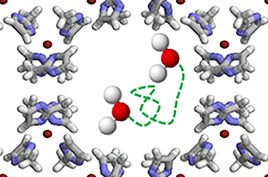J. Wolanin, L. Michel, D. Tabacchioni, J. M. Zanotti, J. Peters, I. Imaz, B. Coasne, M. Plazanet, and C. Picard, J. Phys. Chem. B 125(36) (2021) 10392–10399.
With their strong confining porosity and versatile surface chemistry, zeolitic imidazolate frameworks—including the prototypical ZIF-8—display exceptional properties for various applications. In particular, the forced intrusion of water at high pressure (∼25 MPa) into ZIF-8 nanopores is of interest for energy storage. Such a system reveals also ideal to study experimentally water dynamics and thermodynamics in an ultrahydrophobic confinement. Here, we report on neutron scattering experiments to probe the molecular dynamics of water within ZIF-8 nanopores under high pressure up to 38 MPa. In addition to an overall confinement-induced slowing down, we provide evidence for strong dynamical heterogeneities with different underlying molecular dynamics. Using complementary molecular simulations, these heterogeneities are found to correspond to different microscopic mechanisms inherent to vicinal molecules located in strongly adsorbing sites (ligands) and other molecules nanoconfined in the cavity center. These findings unveil a complex microscopic dynamics, which results from the combination of surface residence times and exchanges between the cavity surface and center.




